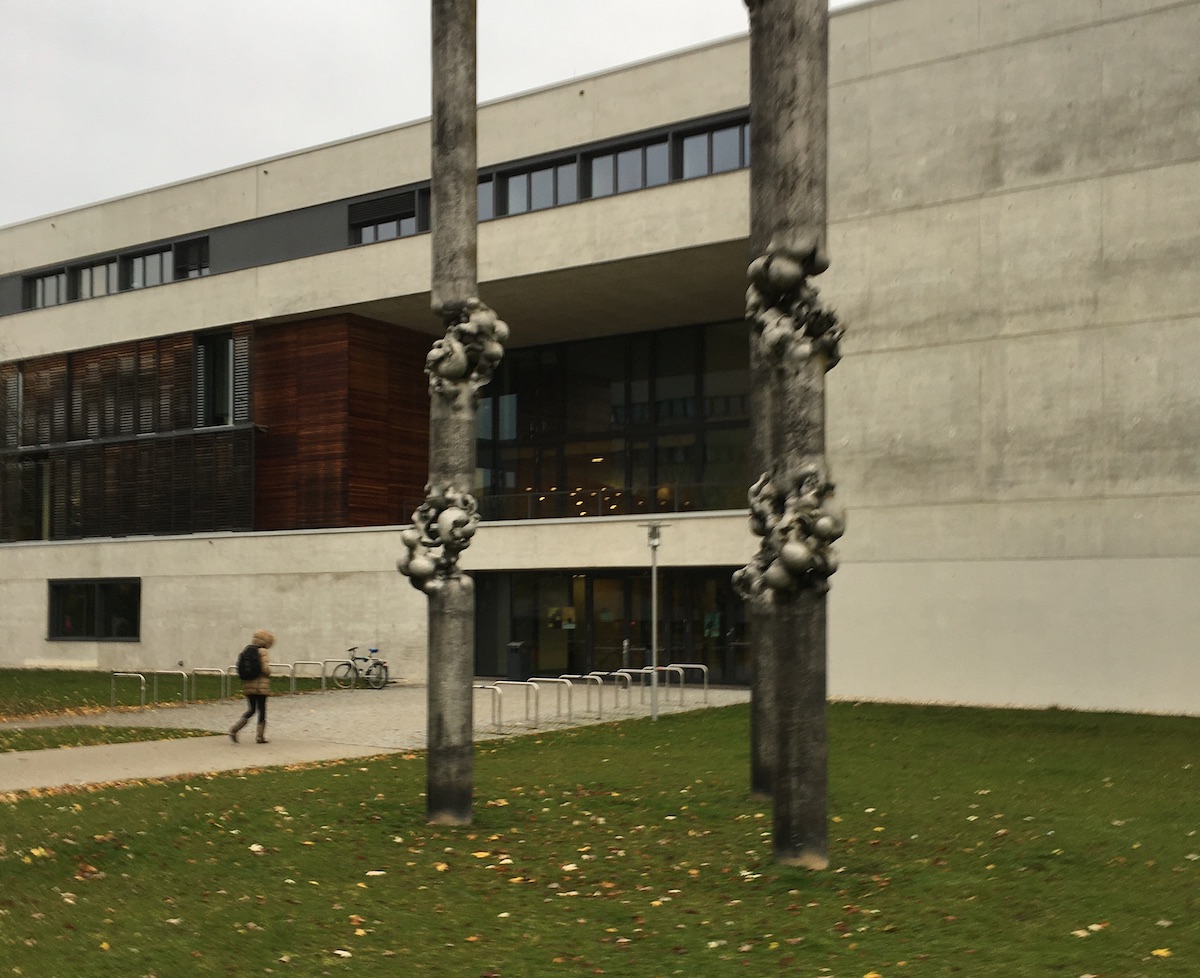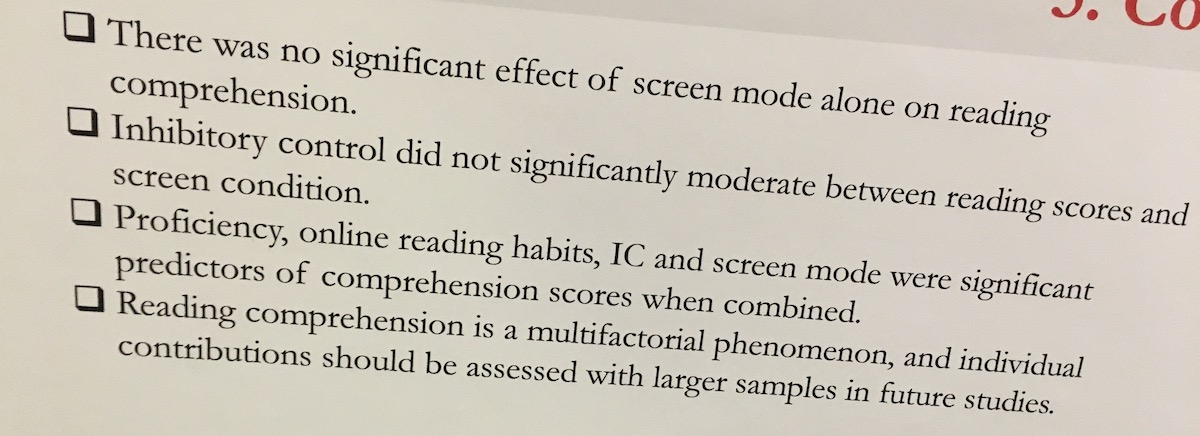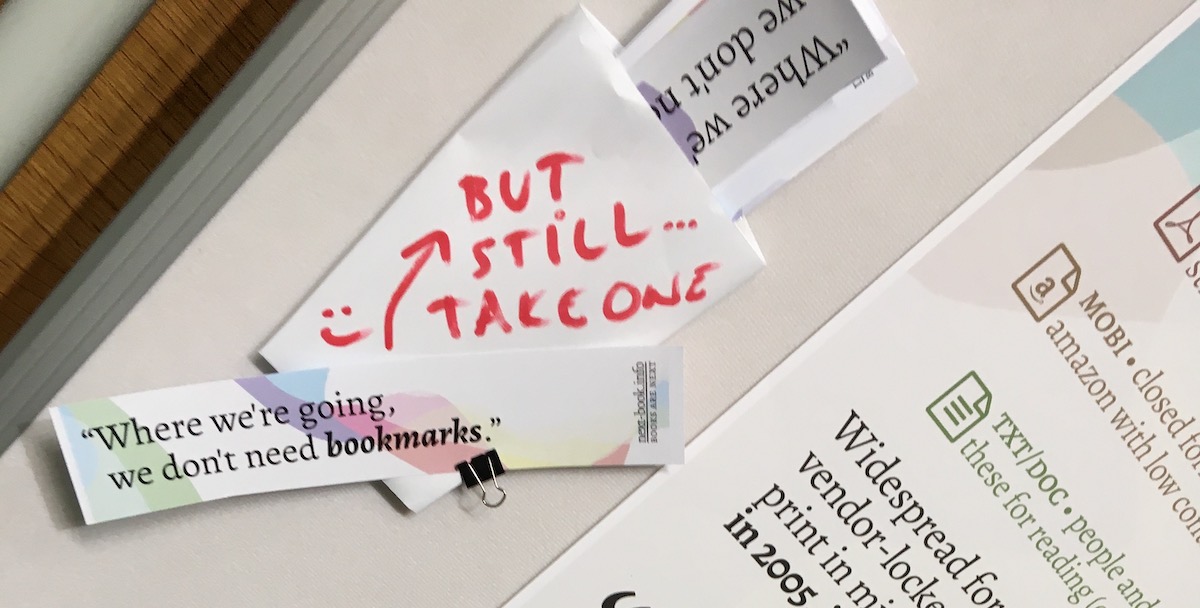Notes from #ReadingConf19
November 8, 2019
The conference Reading in a Digital Environment in Regensburg just ended, and I sat down in a café at Hauptbahnhof to write down some quick notes.

First of all, thanks to the organizers! I’ve met a lot of new people and attended some great sessions. And, of course, a lot of new questions popped up. Here are some quickly drafted notes.
Paper or display?
As expected, this is the most frequently asked question. Is either of those better than the other? Interestingly, most studies come with a definitive „well, maybe not.“

In most studies, there’s no significant difference in various metrics related to reading. Sometimes there’s some specific difference that can be frequently explained by
- inexperienced use (awkward handling of tablets, constrained lab device use),
- recreating paper/digital experience (in either direction) to create a measurable experiment, nullifying the possible differences,
- disregarding the specific digital interfaces that change rapidly as the platforms evolve (even Kindle evolves quite rapidly in this context),
- gradual increase of use of digital devices in reading as the technology becomes more refined, but users developed their behaviors earlier and did not accommodate yet,
- or “shallow” reading habits/behaviors which even bleed into paper-based reading.
This is not to say that these studies are meaningless or saying nothing. Also, these criticisms were frequently addressed in the posters and talks right away. I learned a lot today! (And most of what’s been said supports my focus on the software side of e-reading, so that’s a great validation).
Display or display?
One question kept brewing in me since Anne Mangen’s keynote: is digital/screen really a single medium? We regularly consider cinema and TV to be different media, as the technologies and their social use are different.
However, it’s very much not apparent that the tech behind PDFs, e-readers, or websites is very different. This might be the point that invalidates in extensive measures the conclusions of many talks and posters.
Few people mentioned a distinction between e-ink and the other displays, but again, this notion disregards specific interfaces — buttons/touch, scrolling/jumping, animations, annotation functionalities, typography, etc.
As it is crucial to be careful in assessing how to approach paper/digital in specific uses, I believe it is essential to be much more granular when delineating the media and, therefore, abolish the notion of digital/screen/display media category.

Reading is a lot
This became the second theme of the conference — maybe even overshadowing the first one as the talks continued. Multiple sessions, crowned by the last one, asked what is reading?
On the one hand, it’s good to connect all the dots in the reading puzzle and bring all the concerned experts together. Then again, reading is basically all the stuff you do while you read — e.g., annotating is reading, staring into the ceiling is reading, reading the 135th interesting excerpt aloud to your annoyed roommate is reading, even going to pee is an activity that furthers your reading ability.
This might be an example of conceptual overstretching (for some), but it hammers the point that digital reading serves poorly in many situations. For me, this applied up to this day mostly for niche readers’ needs (e. g. poor annotation capabilities) and reduced social use of books (e. g. browsing friends library), but now I know there’s a lot more that can go wrong.
Always good to learn some new stuff, innit!
People read less
And this is not some general finding — the people who should read the most are reading less. And that’s alarming. The “long long-form” (~novel) is in decline even in an academic setting.
I think this might be attributed to factors such as:
- The current digital solutions are often limited in contrast with their paper alternative, and they’re hard to extend — frequently it’s not a matter of technology, but a business need (as hard as it is, this creates a context, where PDF shines brightly — as something that can be mangled, tortured, cut apart and stitched together and it still works).
- New tech still finds its place and big businesses find ways to teach unhealthy habits (always on, notifications, interfaces hard to put away once opened).
- Changing nature of elementary and high school education (in too many ways to be specific, but the impact of digitization is not small).
- Today’s students find themselves in more precarious circumstances — and not only in the US; I have just a limited experience in Czechia, but it surprised me that half of my full-time students also had a full-time job (I didn’t have the capacity to study this in-depth, though).
- And I think we can hardly overstate the impact of the internet platform creators (Google, Facebook, Apple, Amazon) who use techniques that “enhance user engagement“ that retrain information behaviors of all their users. This is especially relevant in the case of the once hopeful “digital natives” (one of the speakers talked about method of training users to use Google Search critically).
That’s all
Thanks to everybody who dropped by and talked with me about the next-book open web publishing platform (see the poster)! If you’d like to know more, check our website at next-book.info.
If you liked these notes or the poster, maybe subscribe to our newsletter. It’s short (see) and it goes out every other Friday. I’ll compose the next one right after I publish this ☺️.
Also, you may want to follow me on twitter or to discuss this article there.

next-book →
- September 16, 2019 Next-book’s open cloud Next-book makes every book an application. Any reader can utilize all the perks of the open web platform in its current form — both owning the documents and using the power of the network. The reading experience is more than just seeing the lines of text. It’s also using a comfortable device, returning to a book I left unfinished or sharing notes with a friend. A broader infrastructure is required to make such interactions possible.
- July 11, 2019 WPUB and the future of digital publishing Wow. On Monday last week, W3C’s Publishing Working Group decided to shelve the Web Publication’s spec draft (WPUB), citing little support from publishers and browser vendors. Working Group will focus on audiobooks where some traction is present. We attempted standardization before experimentation and incubation. Clear business needs have been hard to find. — Publishing WG Telco, 2019-07-01 WPUB intended to bring publishing to the open web. I’ve been observing the drafting process over the last two years and simultaneously (re)writing a comparison between WPUB and next-book, a cute octopus-shaped project I’ve been working on.
- November 3, 2018 Next-book: browser as a natural environment for e-reading Many people have happy memories of reading their favorite book. So of course, let’s focus on that man on the right, reading on his blackberry. This talk is consciously written as an answer to a big problem. And of course, I’m kinda humbled by the size of it. But of course, I’ll tell you what I believe is the right solution. People say that e-books are in a crisis. The Guardian is running a weekly column just to repeat that fact.
- June 21, 2017 Talkin’ bout pagination and digital books When you think of a book as of an object, you may find that pagination is its nature. It defines how one interacts with a book. It becomes the central affordance of a book. [Book] came to replace the scroll thanks to several problems that limited the scroll’s function and readability. For one, scrolls were very long, sometimes as long as ten meters. This made them hard to hold open and read, a difficulty not helped by the fact that most scrolls in that era were read horizontally, instead of vertically as scrolling virtual documents are read now.
- April 12, 2017 The Next Book I have worked with Ivana Lukeš Rybanská from publishing house Nová Beseda since last year on their digital edition. Well, I finally feel like there’s enough puzzle pieces glued together to speak up about it. And yes, we glued the pieces together to form a ball. Digital books cannot be similar to printed ones as much as printed books do not resemble carved stones. Amazon and most of the EPUB crowd are trying to preserve familiar format and market.